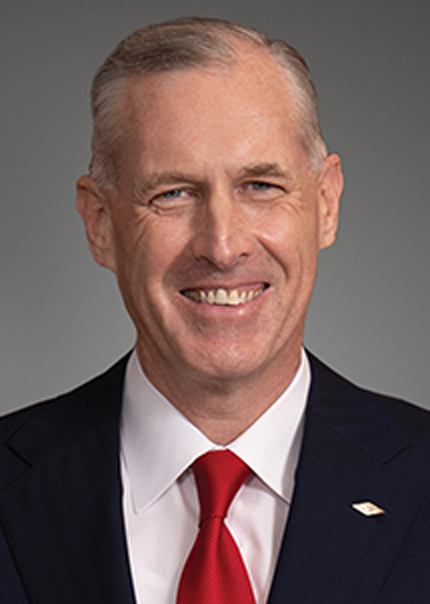Ingots of HALEU derived from pyroprocessing of EBR-II driver fuel at Idaho National Laboratory. (Photo: INL)
On April 7, U.S. Sen. John Barrasso (R., Wyo.), ranking member of the Senate Committee on Energy and Natural Resources, introduced the Fueling Our Nuclear Future Act of 2022. The bill would ensure a domestic supply of high-assay low-enriched uranium (HALEU) for advanced nuclear reactors by directing the Department of Energy to prioritize establishing a domestic HALEU enrichment capability and to use enriched uranium held by the DOE and the National Nuclear Security Administration to fuel advanced reactor demonstrations until U.S. commercial enrichment is available. The bill explicitly excludes uranium sourced or processed by any entity owned or controlled by the governments of Russia and China.
Ontario clean energy leaders. From left: John Gorman, president and chief executive officer of the Canadian Nuclear Association; Ken Hartwick, president and CEO of Ontario Power Generation; Todd Smith, Ontario’s minister of energy; and Mike Rencheck, Bruce Power president and CEO. (Photo: Bruce Power)
Bruce Power and Ontario Power Generation (OPG) have announced an agreement to work together to support new nuclear technologies in Ontario. Bruce Power operates the Bruce nuclear plant and OPG operates the Darlington and Pickering facilities.
Attending the MOU signing on April 5 are, from left, Franc Škrabec, Numip, nuclear power program manager; Tine Ogorevc, Numip, general manager; Josefa Arcarons Coma, Westinghouse, global supply chain manager for the Europe, Middle East, and Africa region; Elias Gedeon, Westinghouse, senior vice president of commercial operations; Joel Eacker, Westinghouse, vice president of new power plant projects; Mojca Lorber, Sipro Engineering, commercial manager; Metod Pirc, Elmont, general manager; and Franc Katič, Sipro Engineering, general manager. (Photo: Westinghouse)
Westinghouse’s plans for supplying AP1000 reactors to Ukraine may have been complicated by Russia’s invasion of the country, but the company is nonetheless continuing its efforts to strengthen business ties in Central and Eastern Europe. On April 5, Westinghouse signed memorandums of understanding with three companies in Slovenia.
A robot called Lyra was used to survey an underground radioactive ventilation duct in Dounreay’s redundant laboratories. (Photo: NDA)
Dounreay Site Restoration Ltd. (DSRL) and the Robotics and Artificial Intelligence in Nuclear (RAIN) Hub, a consortium of universities led by the University of Manchester, are working together on the development of robots capable of accessing areas that are inaccessible or unsafe for humans to work in. The robots will be used to inspect and characterize Dounreay’s laboratories, buildings, and structures as the United Kingdom prepares to decontaminate and decommission the nuclear site.
Energy Harbor’s Perry nuclear power plant, in Perry, Ohio. The company says its nuclear units are “critical infrastructure required for the U.S. clean energy transition.”
Energy Harbor—owner and operator of the Beaver Valley, Davis-Besse, and Perry nuclear power plants—recently announced its plan to become a carbon-free energy infrastructure and supply firm in 2023. Energy Harbor is based in Akron, Ohio.
Artist's rendering of the proposed TRISO-X Fuel Fabrication Facility (TF3) at the Horizon Center Industrial Park, in Oak Ridge, Tenn. (Image: X-energy)
X-energy has announced that its wholly owned subsidiary, TRISO-X, plans to build the TRISO-X Fuel Fabrication Facility, dubbed TF3, at the Horizon Center Industrial Park in Oak Ridge, Tenn. X-energy has produced kilogram quantities of fuel at its pilot plant at Oak Ridge National Laboratory through a public-private partnership.
The commercial plant will use high-assay low-enriched uranium (HALEU) to produce TRISO particles, which are fabricated into fuel forms, including the spherical graphite “pebbles” needed to fuel the company’s Xe-100 high-temperature gas reactor. Site preparation and construction are expected to get underway in 2022, and commissioning and start-up are scheduled for as early as 2025, according to X-energy.
The Kewaunee nuclear power plant in Carlton, Wis.
The Nuclear Regulatory Commission has approved the transfer of the operating license of the shutdown Kewaunee nuclear power plant from Dominion Energy to EnergySolutions. The transfer, which includes the general license for the Wisconsin site’s spent fuel storage facility, is contingent upon approval by the Wisconsin Public Service Commission.
EnergySolutions entered into an agreement with Dominion in May 2021 to acquire the Kewaunee site for decommissioning.
The Diablo Canyon nuclear power plant, located near Avila Beach, Calif.
A recent article on a radio station website about an auxiliary feedwater (AFW) pump problem at the Diablo Canyon nuclear power plant led to information exchanges between a reporter, the American Nuclear Society, and nuclear advocates. The incident also involved a tweet by a member of the Union of Concerned Scientists.
The Wolf Creek nuclear power plant. (Photo: Wolf Creek Nuclear Operating Corp.)
The Department of Justice recently unsealed an indictment charging three Russian nationals with attempting, supporting, and conducting computer intrusions that targeted the global energy sector between 2012 and 2017. One of the targets was Wolf Creek Nuclear Operating Corporation, operator of the single-unit 1200-MWe Wolf Creek nuclear plant near Burlington, Kans.
The Koeberg nuclear power plant, near Cape Town, South Africa. (Photo: Eskom)
An International Atomic Energy Agency team of experts has completed its review of the long-term operational safety of South Africa’s Koeberg nuclear power plant, which is operated by the public utility Eskom.
The New Safe Confinement structure over the damaged fourth reactor at the Chernobyl nuclear power plant. Photo from 2018.
Ukraine’s nuclear operator, Energoatom, announced yesterday that the Russian military has withdrawn from the Chernobyl plant and surrounding area. “According to the staff of the Chernobyl nuclear power plant, there are now no outsiders on-site,” Energoatom stated in an online post. Russian forces took control of Chernobyl on February 24, day one of the invasion.
In a separate post, the company said that the Russians had formally agreed to return the responsibility for Chernobyl to Ukraine. It shared a scan of a document, with the heading “Act of acceptance and transfer of protection of the Chernobyl nuclear plant,” purportedly signed by a representative of Russia’s National Guard, a representative of Rosatom, Russia’s state atomic energy corporation, and a Chernobyl plant shift manager.
Waste packages are loaded with contaminated soil during remediation work at Lawrence Berkeley National Laboratory. (Photo: PermaFix)
Depending on the size and complexity of a decommissioning project, the transportation and disposal of radioactive waste will have an oversized impact on planning, schedule, and budget. The scope of decommissioning a site contaminated with radioactive material begins and ends with the proper and safe packaging of waste and subsequent transportation from the site to the final disposal location. Once all of the waste is gone from the site, the compliance exercise can be completed and the site released from controls (i.e., the radioactive materials license is terminated and the site is decommissioned).






,_July_2020.jpg)
 The Nuclear Regulatory Commission yesterday unveiled its
The Nuclear Regulatory Commission yesterday unveiled its 









